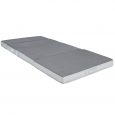Latex and memory foam mattresses are some of the most popular mattresses available today. Unlike traditional spring mattresses, a latex or memory foam mattress is made of a dense, resilient foam. When you lay down on one of these mattresses, you’ll find that it supports your weight better, allowing for even distribution of pressure across your body. And when you get back up, a latex or memory foam mattress springs back into its original shape. So, how exactly are these mattresses made?
Latex
Latex foam is made from latex, a material which is naturally found in rubber trees but can also be produced synthetically. Latex is used in many different products, usually in the form of latex rubber. Disposable medical gloves are often made of latex, for example.
Though either natural or synthetic latex can be used to create latex foam mattresses, natural latex delivers a superior product. Natural latex mattresses are more durable and provide better support for your body. Synthetic latex mattresses are cheaper, but they are less durable and don’t give your body as much support. There are also blended latex mattresses available. These combine natural and synthetic latex to create a mattress that is higher quality than an all-synthetic latex mattress but costs less than an all-natural latex mattress.

To create a latex foam mattress, a process called the Talalay process is used. This process was invented by Leon, Joseph, and Anselm Talalay. It’s a method of molding latex foam into various shapes. The Talalay process is very precise and produces foam to the exact specifications required by the manufacturer.
First, latex rubber is poured into a mold. Then, all the air is vacuumed out of the mold. This creates bubbles in the latex rubber, causing it to rise up and fill out the mold. The next step is to freeze the mold, reducing the temperature down to -20 degrees Fahrenheit. This causes a chemical reaction which results in the foam gelling in place and holding its shape.
Once the mold is frozen in place, the temperature is slowly brought up to 230 degrees Fahrenheit in a process known as vulcanization. This allows the foam to be removed from the mold. Vulcanization also helps to solidify the foam and make it more durable.
Memory Foam
Memory foam is a fairly new type of foam. Memory foam was first invented by NASA as they were searching for a material that would make comfortable cushions and help to protect astronauts from extreme g-forces during take-off.
Memory foam starts out as polyurethane foam. Polyurethane foam is created through a special chemical process, adding water or a special kind of chemical called hyrdocarbons to polyurethane (a substance used in everything from tennis rackets to car seats) to create a foam. To create memory foam, the chemicals are varied slightly.
When the required chemicals are properly mixed, memory foam rises up, sort of like a bread in the oven. Just like bread, it has tiny holes in it. By varying the chemical mixture used to create the foam, manufacturers can change how dense the foam is and how much weight it can withstand without being crushed. The best memory foam is dense and holds up well to body weight but still contours to fit the curves of the body.

After NASA invented memory foam, the formula was released to the public. Many companies now produce memory foam mattresses. However, not all memory foam mattresses are created equal. Some companies add in other types of foam, using only enough memory foam to call their product a “memory foam mattress”. Before you purchase a memory foam mattress, check the density of the foam. If you can, try laying on the mattress to see how far you sink in.




